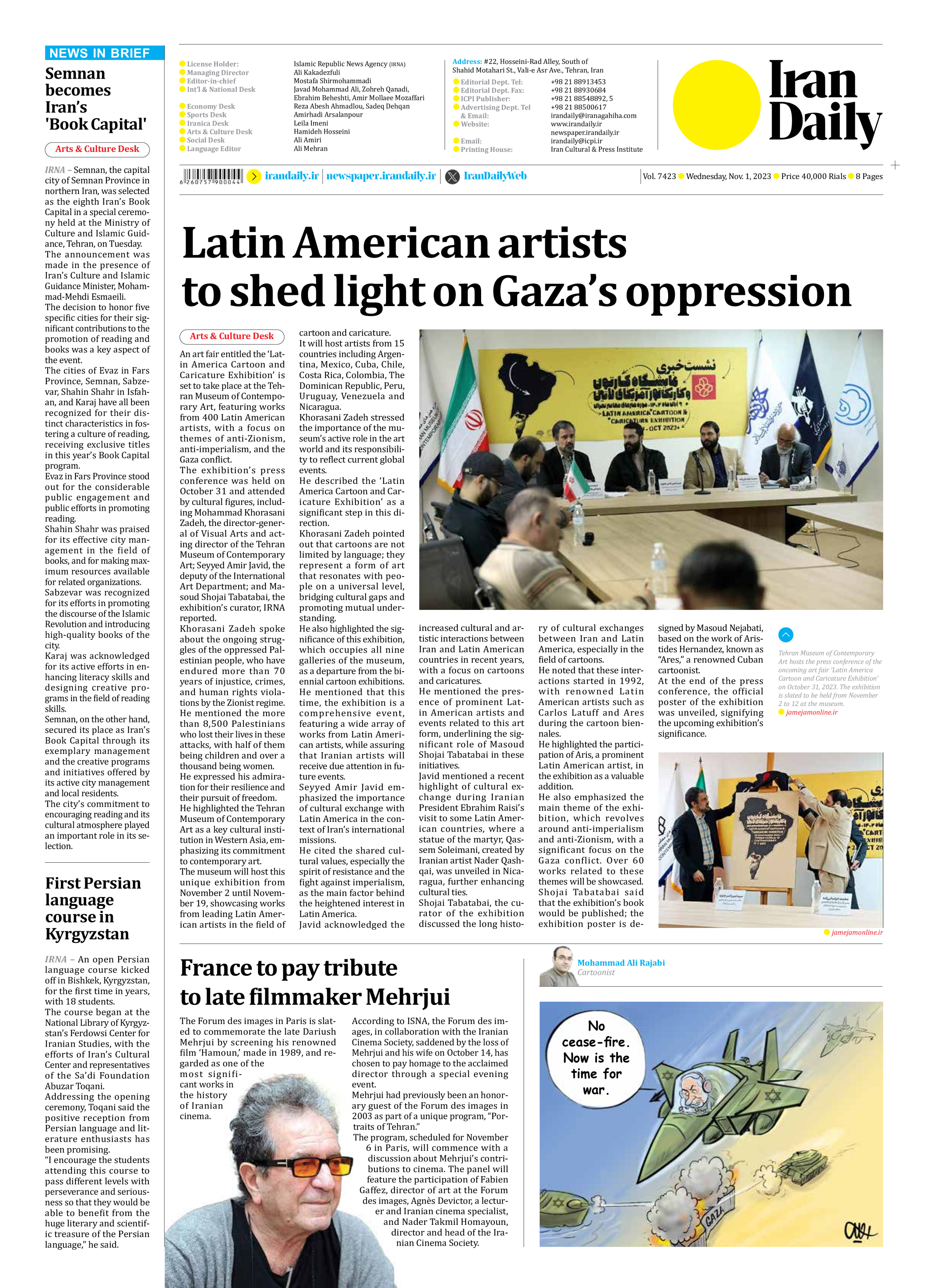
Latin American artists to shed light on Gaza’s oppression
An art fair entitled the ‘Latin America Cartoon and Caricature Exhibition’ is set to take place at the Tehran Museum of Contemporary Art, featuring works from 400 Latin American artists, with a focus on themes of anti-Zionism, anti-imperialism, and the Gaza conflict.
The exhibition’s press conference was held on October 31 and attended by cultural figures, including Mohammad Khorasani Zadeh, the director-general of Visual Arts and acting director of the Tehran Museum of Contemporary Art; Seyyed Amir Javid, the deputy of the International Art Department; and Masoud Shojai Tabatabai, the exhibition’s curator, IRNA reported.
Khorasani Zadeh spoke about the ongoing struggles of the oppressed Palestinian people, who have endured more than 70 years of injustice, crimes, and human rights violations by the Zionist regime.
He mentioned the more than 8,500 Palestinians who lost their lives in these attacks, with half of them being children and over a thousand being women.
He expressed his admiration for their resilience and their pursuit of freedom.
He highlighted the Tehran Museum of Contemporary Art as a key cultural institution in Western Asia, emphasizing its commitment to contemporary art.
The museum will host this unique exhibition from November 2 until November 19, showcasing works from leading Latin American artists in the field of cartoon and caricature.
It will host artists from 15 countries including Argentina, Mexico, Cuba, Chile, Costa Rica, Colombia, The Dominican Republic, Peru, Uruguay, Venezuela and Nicaragua.
Khorasani Zadeh stressed the importance of the museum’s active role in the art world and its responsibility to reflect current global events.
He described the ‘Latin America Cartoon and Caricature Exhibition’ as a significant step in this direction.
Khorasani Zadeh pointed out that cartoons are not limited by language; they represent a form of art that resonates with people on a universal level, bridging cultural gaps and promoting mutual understanding.
He also highlighted the significance of this exhibition, which occupies all nine galleries of the museum, as a departure from the biennial cartoon exhibitions.
He mentioned that this time, the exhibition is a comprehensive event, featuring a wide array of works from Latin American artists, while assuring that Iranian artists will receive due attention in future events.
Seyyed Amir Javid emphasized the importance of cultural exchange with Latin America in the context of Iran’s international missions.
He cited the shared cultural values, especially the spirit of resistance and the fight against imperialism, as the main factor behind the heightened interest in Latin America.
Javid acknowledged the increased cultural and artistic interactions between Iran and Latin American countries in recent years, with a focus on cartoons and caricatures.
He mentioned the presence of prominent Latin American artists and events related to this art form, underlining the significant role of Masoud Shojai Tabatabai in these initiatives.
Javid mentioned a recent highlight of cultural exchange during Iranian President Ebrahim Raisi’s visit to some Latin American countries, where a statue of the martyr, Qassem Soleimani, created by Iranian artist Nader Qashqai, was unveiled in Nicaragua, further enhancing cultural ties.
Shojai Tabatabai, the curator of the exhibition discussed the long history of cultural exchanges between Iran and Latin America, especially in the field of cartoons.
He noted that these interactions started in 1992, with renowned Latin American artists such as Carlos Latuff and Ares during the cartoon biennales.
He highlighted the participation of Aris, a prominent Latin American artist, in the exhibition as a valuable addition.
He also emphasized the main theme of the exhibition, which revolves around anti-imperialism and anti-Zionism, with a significant focus on the Gaza conflict. Over 60 works related to these themes will be showcased.
Shojai Tabatabai said that the exhibition’s book would be published; the exhibition poster is designed by Masoud Nejabati, based on the work of Aristides Hernandez, known as “Ares,” a renowned Cuban cartoonist.
At the end of the press conference, the official poster of the exhibition was unveiled, signifying the upcoming exhibition’s significance.







